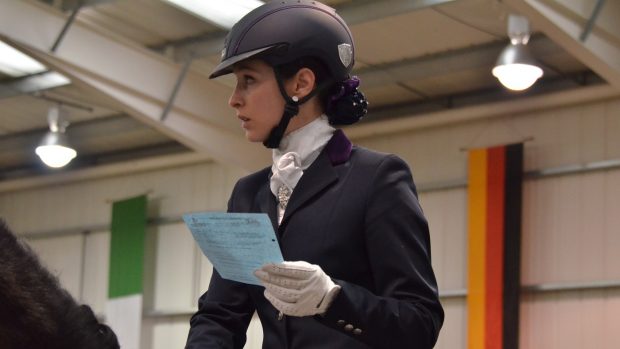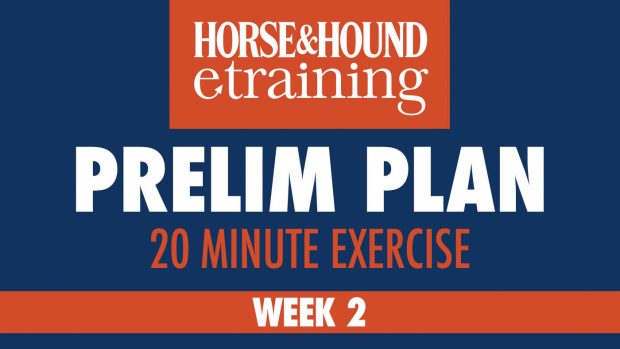We would all love to look like Carl Hester or Charlotte Dujardin while doing flatwork with our horses. To help you on your way, here are some useful tips to help you work towards improving your position.
{"content":"PC9wPgo8aDM+PHN0cm9uZz4xLiBUaHJlZSBwb2ludHM8L3N0cm9uZz48L2gzPgo8cD5Gb2N1cyBvbiBvYnRhaW5pbmcgdGhlIHRocmVlIGNvbm5lY3Rpb24gcG9pbnRzIHdpdGggeW91ciBzZWF0IOKAlCB5b3VyIGNyb3RjaCBhbmQgdHdvIHNlYXQgYm9uZXMgaW4gdGhlIGRlZXBlc3QgcGFydCBvZiB5b3VyIHNhZGRsZS4gTWFrZSBzdXJlIHlvdXIgYm9keSBpcyBzeW1tZXRyaWNhbCBvbiBlYWNoIHNpZGUuIElmIHlvdSBzaXQg4oCYd29ua3nigJkgdGhlbiB5b3VyIGhvcnNlIHdpbGwgbGVhcm4gdG8gYWRqdXN0IHRvIHlvdSBhbmQgYWxzbyBiZWNvbWUgY3Jvb2tlZCBpbiBoaXMgcmlkZGVuIHdvcmsuPC9wPgo8cD48ZGl2IGNsYXNzPSJhZC1jb250YWluZXIgYWQtY29udGFpbmVyLS1tb2JpbGUiPjxkaXYgaWQ9InBvc3QtaW5saW5lLTEiIGNsYXNzPSJpcGMtYWR2ZXJ0Ij48L2Rpdj48L2Rpdj48ZGl2IGlkPSJ0YWJvb2xhLW1pZC1hcnRpY2xlIj48L2Rpdj48c2NyaXB0PndpbmRvdy5fdGFib29sYVNsb3RzPXdpbmRvdy5fdGFib29sYVNsb3RzfHxbXTt3aW5kb3cuX3RhYm9vbGFTbG90cy5wdXNoKHsibW9kZSI6InRodW1ibmFpbHMtYS1taWQiLCJjb250YWluZXIiOiJ0YWJvb2xhLW1pZC1hcnRpY2xlIiwicGxhY2VtZW50IjoiTWlkIEFydGljbGUiLCJ0YXJnZXRfdHlwZSI6Im1peCJ9KTs8L3NjcmlwdD48c2VjdGlvbiBpZD0iZW1iZWRfY29kZS0zNiIgY2xhc3M9IiBzLWNvbnRhaW5lciBzdGlja3ktYW5jaG9yIGhpZGUtd2lkZ2V0LXRpdGxlIHdpZGdldF9lbWJlZF9jb2RlIHByZW1pdW1faW5saW5lXzEiPjxkaXYgc3R5bGU9InBhZGRpbmc6IDBweCAhaW1wb3J0YW50OyI+PGRpdiBpZD0icGlhbm8tcGF5d2FsbC1tZXRlci1iYXJyaWVyIiBzdHlsZT0idGV4dC1hbGlnbjogY2VudGVyOyB2ZXJ0aWNhbC1hbGlnbjogbWlkZGxlOyI+PC9kaXY+PC9kaXY+DQoNCjxzdHlsZT4NCiNwaWFuby1wYXl3YWxsLW1ldGVyLWJhcnJpZXIgLnRwLWNvbnRhaW5lci1pbm5lciB7DQogICAgcG9zaXRpb246IGFic29sdXRlOw0KICAgIGhlaWdodDogOTk5OTlweCAhaW1wb3J0YW50Ow0KICAgIGJhY2tncm91bmQ6IGxpbmVhci1ncmFkaWVudCgxODBkZWcsIHRyYW5zcGFyZW50IDYwMHB4LCB3aGl0ZSA4NTBweCk7DQp9DQo8L3N0eWxlPjwvc2VjdGlvbj48c2VjdGlvbiBpZD0ia2V5c3RvbmUtdm9lcC13aWRnZXQtMyIgY2xhc3M9IiBzLWNvbnRhaW5lciBzdGlja3ktYW5jaG9yIGtleXN0b25lLXZvZXAtd2lkZ2V0IHByZW1pdW1faW5saW5lXzEiPgo8ZGl2IGNsYXNzPSJqd3BsYXllci1jb250YWluZXIgandwbGF5ZXItbWFyZ2luLWJvdHRvbSI+CjxkaXYgY2xhc3M9Imp3cGxheWVyLXdyYXBwZXIiPgo8ZGl2IGNsYXNzPSJqd3BsYXllci1taW5pbWl6ZS1jbG9zZSI+CgkJCQk8c3ZnIHhtbG5zPSJodHRwOi8vd3d3LnczLm9yZy8yMDAwL3N2ZyIgY2xhc3M9Imp3LXN2Zy1pY29uIGp3LXN2Zy1pY29uLWNsb3NlIiB2aWV3Qm94PSIwIDAgMjQwIDI0MCIgZm9jdXNhYmxlPSJmYWxzZSI+CgkJCQkJPHBhdGggZD0iTTEzNC44LDEyMGw0OC42LTQ4LjZjMi0xLjksMi4xLTUuMiwwLjItNy4yYzAsMC0wLjEtMC4xLTAuMi0wLjJsLTcuNC03LjRjLTEuOS0yLTUuMi0yLjEtNy4yLTAuMmMwLDAtMC4xLDAuMS0wLjIsMC4yTDEyMCwxMDUuMkw3MS40LDU2LjZjLTEuOS0yLTUuMi0yLjEtNy4yLTAuMmMwLDAtMC4xLDAuMS0wLjIsMC4yTDU2LjYsNjRjLTIsMS45LTIuMSw1LjItMC4yLDcuMmMwLDAsMC4xLDAuMSwwLjIsMC4ybDQ4LjYsNDguN2wtNDguNiw0OC42Yy0yLDEuOS0yLjEsNS4yLTAuMiw3LjJjMCwwLDAuMSwwLjEsMC4yLDAuMmw3LjQsNy40YzEuOSwyLDUuMiwyLjEsNy4yLDAuMmMwLDAsMC4xLTAuMSwwLjItMC4ybDQ4LjctNDguNmw0OC42LDQ4LjZjMS45LDIsNS4yLDIuMSw3LjIsMC4yYzAsMCwwLjEtMC4xLDAuMi0wLjJsNy40LTcuNGMyLTEuOSwyLjEtNS4yLDAuMi03LjJjMCwwLTAuMS0wLjEtMC4yLTAuMkwxMzQuOCwxMjB6Ij48L3BhdGg+CgkJCQk8L3N2Zz4KCQkJPC9kaXY+CjxkaXYKCQkJCWRhdGEtcGxheWVyPSJLTVVjblJpSSIKCQkJCWRhdGEta2V5PSJzQU9QdnpsMyIKCQkJCWRhdGEtbG9hZGVkPSJmYWxzZSIKCQkJCWNsYXNzPSJqd3BsYXllciIKCQkJCWlkPSJqd3BsYXllcl9zQU9QdnpsM19LTVVjblJpSV82OV9kaXYiPgoJCQk8L2Rpdj4KPC9wPjwvZGl2Pgo8L3A+PC9kaXY+Cjwvc2VjdGlvbj48L3A+CjxoMz48c3Ryb25nPjIuIExvbmcgbGVnczwvc3Ryb25nPjwvaDM+CjxwPkV2ZW4gaWYgeW91IGRvbuKAmXQgaGF2ZSBsb25nIGxlZ3MsIGl0IGlzIGltcG9ydGFudCB0aGF0IHlvdSBzdGlsbCB0aGluayDigJhsb25n4oCZIHdpdGggeW91ciBsZWdzLiBTdHJldGNoIHlvdXIgdGhpZ2ggYmFjayBmcm9tIHlvdXIgaGlwLCBwb2ludGluZyB5b3VyIGtuZWUgdG93YXJkcyB0aGUgZ3JvdW5kLiBMZXQgeW91ciBjYWxmIGZhbGwgYmVsb3cgeW91ciBrbmVlIGFuZCBwdXNoIHRvd2FyZHMgdGhlIGdyb3VuZC4gS2VlcCB3ZWlnaHQgaW4geW91ciBoZWVsLCBub3QgeW91ciB0b2UuIFN0YXkgcmVsYXhlZCwgYW5kIHRyeSBhcyBoYXJkIGFzIHBvc3NpYmxlIG5vdCB0byBncmlwIHdpdGggYW55IHBhcnQgb2YgeW91ciBsZWcg4oCUIHRoZSBtb3N0IGNvbW1vbiBwYXJ0IG9mIHRoZSBsZWcgdGhhdCByaWRlcnMgZ3JpcCB3aXRoIGlzIHRoZSBrbmVlIGFuZCB0aGlnaCBzbyBsb29rIG91dCBmb3IgdGhpcy48L3A+CjxoMz48c3Ryb25nPjMuIFVwcGVyIGJvZHk8L3N0cm9uZz48L2gzPgo8cD5UaGluayDigJh0YWxs4oCZIHRocm91Z2ggeW91ciBib2R5IGJ5IHN0cmV0Y2hpbmcgeW91ciBhYmRvbWluYWwgbXVzY2xlcyB1cHdhcmRzLCB3aGljaCB3aWxsIGluIHR1cm4gbGVuZ3RoZW4geW91ciBiYWNrLiBUaGluayBvZiBzdGFja2luZyB5b3VyIHVwcGVyIGJvZHkgb24gdGhlIHRocmVlIHBvaW50cyBvZiB5b3VyIHNlYXQuIFZpZXdlZCBmcm9tIHRoZSBzaWRlLCB5b3Ugd2FudCB0byBoYXZlIGEgc3RyYWlnaHQgbGluZSBmcm9tIHlvdXIgZWFyIHRvIHlvdXIgc2hvdWxkZXIsIGhpcCBhbmQgaGVlbC48L3A+CjxoMz48c3Ryb25nPjQuIENvcmUgc3RyZW5ndGg8L3N0cm9uZz48L2gzPgo8cD48ZGl2IGNsYXNzPSJhZC1jb250YWluZXIgYWQtY29udGFpbmVyLS1tb2JpbGUiPjxkaXYgaWQ9InBvc3QtaW5saW5lLTIiIGNsYXNzPSJpcGMtYWR2ZXJ0Ij48L2Rpdj48L2Rpdj48c2VjdGlvbiBpZD0iZW1iZWRfY29kZS0zMSIgY2xhc3M9ImhpZGRlbi1tZCBoaWRkZW4tbGcgcy1jb250YWluZXIgc3RpY2t5LWFuY2hvciBoaWRlLXdpZGdldC10aXRsZSB3aWRnZXRfZW1iZWRfY29kZSBwcmVtaXVtX2lubGluZV8yIj48c2VjdGlvbiBjbGFzcz0icy1jb250YWluZXIgbGlzdGluZy0tc2luZ2xlIGxpc3RpbmctLXNpbmdsZS1zaGFyZXRocm91Z2ggaW1hZ2UtYXNwZWN0LWxhbmRzY2FwZSBkZWZhdWx0IHNoYXJldGhyb3VnaC1hZCBzaGFyZXRocm91Z2gtYWQtaGlkZGVuIj4NCiAgPGRpdiBjbGFzcz0icy1jb250YWluZXJfX2lubmVyIj4NCiAgICA8dWw+DQogICAgICA8bGkgaWQ9Im5hdGl2ZS1jb250ZW50LW1vYmlsZSIgY2xhc3M9Imxpc3RpbmctaXRlbSI+DQogICAgICA8L2xpPg0KICAgIDwvdWw+DQogIDwvZGl2Pg0KPC9zZWN0aW9uPjwvc2VjdGlvbj48L3A+CjxwPlRoZSB3b3JsZOKAmXMgdG9wIHJpZGVycyB3b3JrIHZlcnkgaGFyZCBvbiBoYXZpbmcgYXMgbXVjaCBzdHJlbmd0aCBhcyBwb3NzaWJsZSB0aHJvdWdoIHRoZWlyIGNvcmUuIFRoaXMgaGVscCByaWRlcnMgdG8gZm9sbG93IHRoZSBtb3ZlbWVudCBvZiB0aGVpciBob3JzZXMgZnJlZWx5LCB3aXRob3V0IGNvbGxhcHNpbmcgYW5kIGxvc2luZyBiYWxhbmNlLiBFeGVyY2lzZXMgc3VjaCBhcyBzaXQgdXBzIGFuZCB0aGUgcGxhbmssIHBsdXMgZ3ltIGNsYXNzZXMgbGlrZSBwaWxhdGVzIGNhbiByZWFsbHkgaGVscCB0byBpbXByb3ZlIHlvdXIgY29yZSBzdHJlbmd0aC48L3A+CjxoMz48c3Ryb25nPjUuIEx1bmdlPC9zdHJvbmc+PC9oMz4KPGRpdiBjbGFzcz0iaW5qZWN0aW9uIj48L2Rpdj4KPHA+RG9pbmcgcmlkZGVuIHdvcmsgd2hpbGUgb24gdGhlIGx1bmdlIGhlbHBzIHlvdSB0byBjb25jZW50cmF0ZSBvbiB5b3VyIHBvc2l0aW9uIGFuZCBiYWxhbmNlLiBJdCBjYW4gbWFrZSB5b3UgcmVhbGlzZSBob3cgZGVwZW5kZW50IHlvdSBhcmUgb24geW91ciByZWlucyBhbmQgaXQgY2FuIGhlbHAgZGV2ZWxvcCBhIGxvbmdlciBsZWcgYW5kIGRlZXBlciBzZWF0IHdoaWNoIGhlbHBzIHlvdSB0byBmb2xsb3cgbW90aW9uIG9mIGhvcnNlLiBXYXJtIHVwIHdpdGggc3RpcnJ1cHMgYW5kIHRoZW4gdGFrZSB0aGVtIGF3YXksIHdvcmtpbmcgZnJvbSB3YWxrIHVwIHRvIGNhbnRlci4gWW91IGNhbiB0YWtlIHlvdXIgc3RpcnJ1cHMgYmFjayBhdCB0aGUgZW5kIG9mIHRoZSBzZXNzaW9uIHRvIGhlbHAgeW91IGZlZWwgdGhlIGltcHJvdmVtZW50LjwvcD4KPHA+PGVtPkhvcnNlICZhbXA7IEhvdW5kIG1hZ2F6aW5lLCBvdXQgZXZlcnkgVGh1cnNkYXksIGlzIHBhY2tlZCB3aXRoIGFsbCB0aGUgbGF0ZXN0IG5ld3MgYW5kIHJlcG9ydHMsIGFzIHdlbGwgYXMgaW50ZXJ2aWV3cywgc3BlY2lhbHMsIG5vc3RhbGdpYSwgdmV0IGFuZCB0cmFpbmluZyBhZHZpY2UuIDxhIGhyZWY9Imh0dHBzOi8vd3d3LmhvcnNlYW5kaG91bmQuY28udWsvc3Vic2NyaXB0aW9ucy9ob3JzZS1ob3VuZC1zdWJzY3JpcHRpb25zIj5GaW5kIG91dCBtb3JlIGFib3V0IGdldHRpbmcgdGhlIG1hZ2F6aW5lIGRlbGl2ZXJlZDwvYT4gdG8geW91ciBkb29yIGV2ZXJ5IHdlZWsuPC9lbT48L3A+CjxwPgo="}
This site is protected by reCAPTCHA and the Google Privacy Policy and Terms of Service apply.



